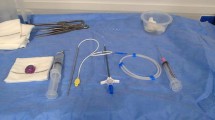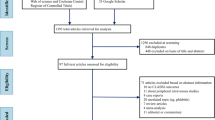Abstract
Background
No randomized trials have so far investigated the cost effectiveness of different methods for implantation and use of central venous ports in oncology patients.
Patients and Methods
Overall, 403 patients eligible for receiving intravenous chemotherapy for solid tumours were randomly assigned to implantation of a single type of port, either through a percutaneous landmark access to the internal jugular vein, an ultrasound (US)-guided access to the subclavian vein, or a surgical cut-down access through the cephalic vein at the deltoid-pectoralis groove. Insertion and maintenance costs were estimated by obtaining the charges for an average implant and use, while the costs of the management of complications were analytically assessed. The total cost was defined as the purchase cost plus the insertion cost plus the maintenance cost plus the cost of treatment of the complications, if any.
Results
A total of 401 patients were evaluable—132 with the internal jugular vein, 136 with the subclavian vein and 133 with the cephalic vein access. No differences were found for the rate of early complications. The US-guided subclavian insertion site had significantly lower failures. Infections occurred in 1, 3, and 3 patients (internal jugular, subclavian, and cephalic access, respectively; p = 0.464), whereas venous thrombosis was observed in 15, 8, and 11 patients, respectively (p = 0.272). Mean cost for purchase, implantation, diagnosis and treatment of complications in each patient was €2,167.85 for subclavian US-guided, €2,335.87 for cephalic, and €2,384.10 for internal jugular access, respectively (p = 0.0001).
Conclusion
US real-time guidance to the subclavian vein resulted in the most cost-effective method of central venous port placement and use.

Similar content being viewed by others
References
Biffi R, Corrado F, De Braud F, et al. Long term, totally implantable central venous access ports connected to Groshong catheter for chemotherapy of solid tumours: experience on 178 cases using a single type of device. Eur J Cancer. 1997;33:1190–1194.
Biffi R, De Braud F, Orsi F, et al. A randomized, prospective trial of central venous ports connected to standard open-ended or Groshong catheters in adult oncology patients. Cancer. 2001;92:1204–1212.
Biffi R, Orsi F, Pozzi S, et al. Best choice of central venous insertion site for the prevention of catheter-related complications in adult patients who need cancer therapy: a randomized trial. Ann Oncol. 2009;20:935–940.
Biffi R, Orsi F, Pozzi S, et al. No impact of central venous insertion site on oncology patients’ quality of life and psychological distress: a randomized three-arm trial. Support Care Cancer. 2011;19(10):1573–1580.
Sticca RP, Dewing BD, Harris JD. Cost issues. In: Di Carlo I, Biffi R, editors. Totally implantable venous access devices. Springer-Verlag Italia;2011.
Biffi R, de Braud F, Orsi F, et al. Totally implantable central venous access ports for long term chemotherapy: a prospective study analysing complications and costs in 333 devices with a minimum 180 days of follow-up. Ann Oncol. 1998;9:767–773.
Sticca RP, Dewing BD, Harris JD. Outcomes of surgical and radiologic placed implantable central venous access ports. Am J Surg. 2009;198:829–833.
Ignatov A, Hoffman O, Smith B, et al. An 11-year retrospective study of totally implanted central venous access ports: complications and patient satisfaction. Eur J Surg Oncol. 2009;35:241–246.
Hancock HR, Connolly BL, McMahon M, et al. Cost-effectiveness analysis of implantable venous access device insertion using interventional radiologic versus conventional operating room methods in pediatric patients with cancer. J Vasc Interv Radiol. 2010;5:677–684.
Marcy PY, Magné N, Castadot P, et al. Radiological and surgical placement of port devices: a 4-year institutional analysis of procedure performance, quality of life and cost in breast cancer patients. Breast Cancer Res Treat. 2005;92:61–67.
Liu GF, Wang J, Liu K, Snavely DB. Confidence intervals for an exposure adjusted incidence rate difference with applications to clinical trials. Stat Med. 2006;25:1275–1286.
O’Brien PC, Fleming TR. A multiple testing procedure for clinical trials. Biometrics. 1979;35:549–556.
Gallieni M, Pittiruti M, Biffi R. Vascular access in oncology patients. CA Cancer J Clin. 2008;58:323–346.
Kreis H, Loehberg CR, Lux MP, et al.Patients’ attitudes to totally implantable venous access port systems for gynecological or breast malignancies. Eur J Surg Oncol. 2007;33:39–43.
Mueller BU, Skelton J, Callender DP. A prospective randomized trial comparing the infectious and noninfectious complications of an externalized catheter versus a subcutaneously implanted device in cancer patients. J Clin Oncol. 1992;10:1943–1948.
Ng F, Mastoroudes H, Paul E, et al. A comparison of Hickman line and Port-a-Cath associated complications in patients with solid tumours undergoing chemotherapy. Clin Oncol (R Coll Radiol). 2007;19:551–556.
Hind D, Caivert N, McWilliams R, et al. Ultrasonic locating devices for central venous cannulation: meta-analysis. BMJ. 2003;327:361–367.
Calvert N, Hind D, McWilliams R, et al. Ultrasound for central venous cannulation: economic evaluation of cost-effectiveness. Anaesthesia. 2004;59:1116–1120.
Biffi R, Pozzi S, Cenciarelli S, et al. Treatment of pneumothorax as a complication of long-term central venous port placement in oncology patients: an observational study. J Vasc Access. 2001;2(3):129–136.
Kim JS, Holtom P, Vigen C. Reduction of catheter-related bloodstream infections through the use of a central venous line bundle: epidemiologic and economic consequences. Am J Infect Control. 2011;39(8):640–646.
Cooper K, Frampton G, Harris P, et al. Are educational interventions to prevent catheter-related bloodstream infections in intensive care unit cost-effective? J Hosp Infect. 2014;86(1):47–52.
Maki DG, Kluger DM, Crnich CJ. The risk of bloodstream infection in adults with different intravascular devices: a systematic review of 200 published prospective studies. Mayo Clinic Proc. 2006;81:1159–1171.
Vescia S, Baumgärtner AK, Jacobs VR, et al. Management of venous port systems in oncology: a review of current evidence. Ann Oncol. 2008;19:9–15.
Verso M, Agnelli G. Venous thromboembolism associated with long-term use of central venous catheters in cancer patients. J Clin Oncol. 2003;21:3665–3675.
Akl EA, Kamath G, Yosuico V, et al. Thromboprophylaxis for patients with cancer and central venous catheters: a systematic review and a meta-analysis. Cancer. 2008;112:2483–2492.
Chaukiyal P, Nautiyal A, Radhakrishnan S, et al. Thromboprophylaxis in cancer patients with central venous catheters: a systematic review and meta-analysis. Thromb Haemost. 2008;99:38–43.
Acknowledgment
This study has been supported by a biennial research grant from AIRC—Associazione Italiana per la Ricerca sul Cancro (Italian Association for Cancer Research), Grant Application Number 1126. Bard Italia, Rome, offered technical support for this study.
Conflict of interest
None.
Author information
Authors and Affiliations
Corresponding author
Rights and permissions
About this article
Cite this article
Biffi, R., Pozzi, S., Bonomo, G. et al. Cost Effectiveness of Different Central Venous Approaches for Port Placement and Use in Adult Oncology Patients: Evidence From a Randomized Three-Arm Trial. Ann Surg Oncol 21, 3725–3731 (2014). https://doi.org/10.1245/s10434-014-3784-5
Received:
Published:
Issue Date:
DOI: https://doi.org/10.1245/s10434-014-3784-5




